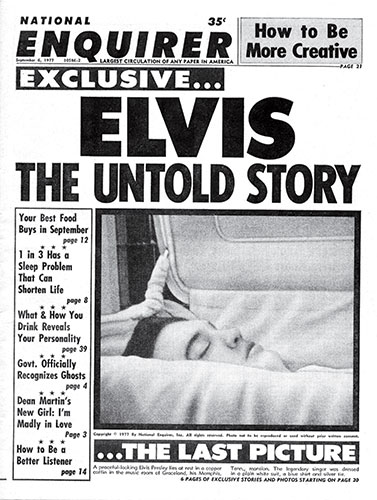Did an MIT alumnus found the National Enquirer? Enquiring minds want to know.
-
-
slice.mit.edu
Filed Under
Recommended
 This Sept. 1977 issue of the National Enquirer
This Sept. 1977 issue of the National Enquirer
Have you ever wondered who was responsible for bizarre National Enquirer headlines like “Adam and Eve were Astronauts,” “UFOs: The Big Govt. Cover-Up,” and “Man Eats Dog?” If so, Slice has your answer—and he’s an MIT alumnus.
The National Enquirer was founded and published by Generoso Pope, Jr. ’46, a former CIA operative who graduated from MIT in less than three years.
From The Godfather of Tabloid: Generoso Pope, Jr. and the National Enquirer, by Jack Vitek“Pope breezed through MIT in two and a half years, by way of an accelerated wartime program, and earned, at age nineteen, a degree in mechanical engineering that he never used. Though he described himself as a 'science nut,' Pope also said that he never wanted to be an engineer but went to MIT because engineering fascinated him, that studying engineering taught him to think logically.”

After graduation, Pope became editor and publisher of the Il Progresso Italo-Americano, an Italian-language daily newspaper in New York City owned by his father, Generoso Pope, Sr.
In 1950, he left Il Progresso and spent one year working for the CIA as a psychological warfare officer during the peak of the first Cold War.
In 1952, the 25-year-old Pope returned to New York and purchased the New York Enquirer, a Sunday weekly paper with a circulation of 17,000, for $75,000. Within a year, he dropped the paper’s sports-politics-news format and adopted a tabloid set-up.
Four years later, after watching a crowd gather round the aftermath of a car accident, Pope encouraged his staff to focus on gruesome photos and hard-to-believe headlines like, “I Cut Out Her Heart and Stomped on It.” By 1966, the paper was renamed the National Enquirer and circulation exceeded 1 million.
But the grisly subject matter prevented the tabloid from being sold in supermarkets. So in the early 1970s, Pope shifted the Enquirer’s content again, this time focused heavily on celebrity gossip. (Pope later published another tabloid, Weekly World News, that featured the macabre stories the Enquirer no longer covered.)
In the 1970s, circulation peaked at 5.7 million and the Enquirer’s cover touted the tagline “Biggest Circulation of Any Paper in America.” A September 1977 issue, with a front page photo of a deceased Elvis Presley under the headline "Elvis: The Untold Story," sold 6.7 million copies. A later issue, headlined by "Drinking Beer Prevents Heart Attacks," sold 6.3 million.
But Pope’s journalistic practices—like over-intrusive celebrity reporting, paying sources, and a devil-may-care approach to fact-vetting—earned the ire of many public figures, including actress Carol Burnett, who won a libel defamation suit against the Enquirer in 1981.
Pope was also well-known for his ill-fated pursuit to break the Guinness Book of World Records mark for world’s tallest Christmas tree. For more than 15 years, Pope would commission the Christmas-time installation and decoration of a massive Douglas fir at the Enquirer’s Florida headquarters, at an annual cost of more than $1 million. The largest tree measured 125 feet high, and could be seen for miles, but was far shorter than the 150-foot tree in Guinness books.
After his death, the Enquirer empire was sold to American Media, Inc., for $412 million.
From The Godfather of Tabloid “No one at the Enquirer, not its cynical journalists and least of all Pope, who was after all a graduate of MIT, had to really believe these improbable stories about junk science, UFOs and Bigfoot; all they had to believe was that someone else did, or said they did.”







